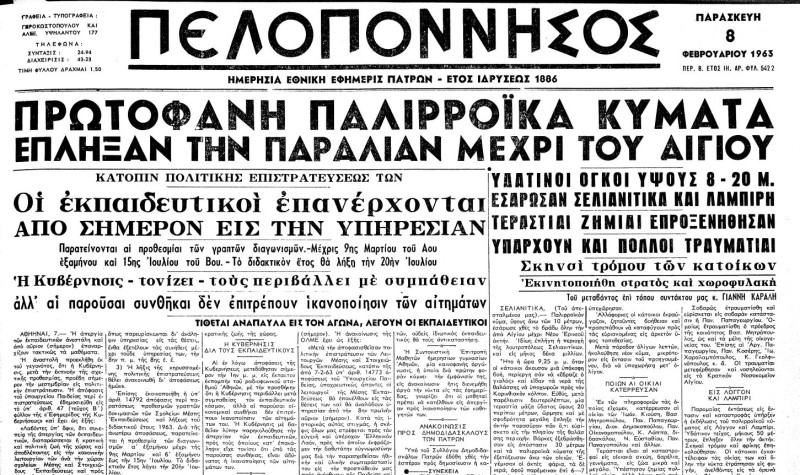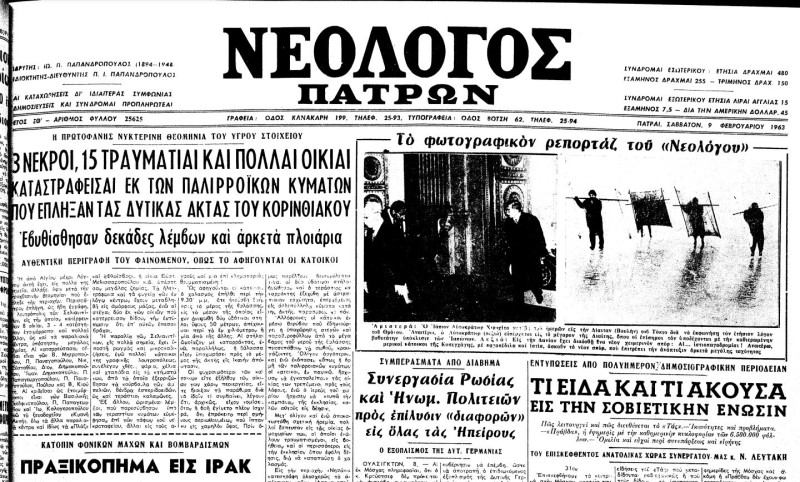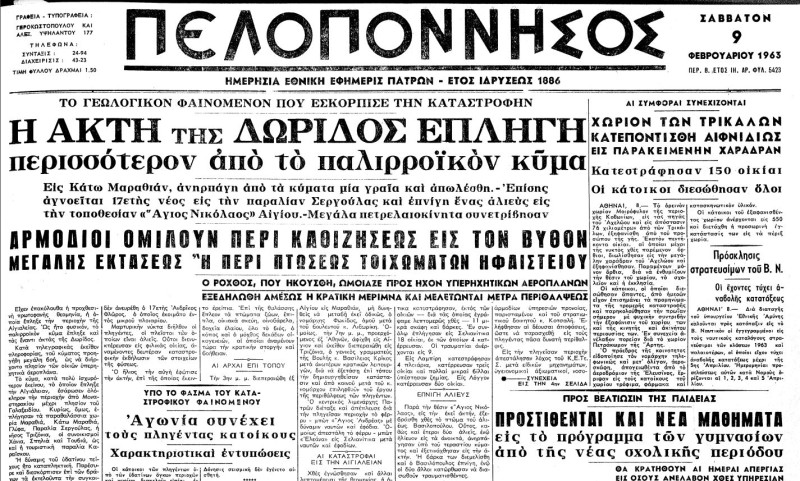“The inhabitants of the residents were asking for help and attempt to resort to the location high in a sufficient height of location”
To 7 February 1963that is, 62 years ago, tidal waves were created in the Corinthian Gulf after an underwater earthquake, which, according to testimonies, arrived at height of many meters.
The “tsunami” hit the coastal areas of Aigialia, in Achaia, Dorida and Fokida. By tidal waves lost their lives at least four people and about 20 were injured, causing extensive damage.
Newspapers of that time, such as the “Neologos” of Patras and the “Peloponnese” recorded in extensive reports of what happened, and the testimonies of residents of the affected areas were characteristic. At the same time, the announcement of the Seismological Institute of the Athens Observatory has been recorded on the causes caused by tidal waves and were attributed to underwater landslide after seismic vibrations.
Also, the areas of Aigialia and Dorida were visited by the then director of the Seismological Institute, Professor of Seismology Angelos Galanopoulos, who was even from the Achaia area of Riolos.
The Athenian -Macedonian News Agency today presents what the two newspapers of Patras have recorded in their reports, the leaves of which are kept and kept digitized at the Museum of the Peloponnese Daily Newspaper Association, Epirus.
The time of the disaster through the local press
On Friday, February 8, 1963, the first reports were recorded.
In the “Neologos”, the theme is top on page 4 (back cover) and is entitled: “Tidal wave hit the Aktios from Aigio to Psathopyrgos yesterday. The waters were in depth from 20 to 50 meters into land. 10 injured and collapsing houses in Selianitika. Panic among residents. Damage to other areas »..
The following report describes, inter alia: “A resident of the Selianitikas of the sea by the sea waves and was dropped on the estate, capable of the shore. Against information from Aigio, The first wave was raised around 9:20 pm and like a water barrierit was fired after Patagou. The marine waters reached a depth of more than 50 meters in land. The tidal waves were up to 11:15 pm, while the inhabitants abandoned their homes and were being safer to safer parts of the city.”
To ‘Peloponnese“, The topic is toppage on the front page, entitled:” unprecedented tidal waves hit the beach to Aigio. Aquatic tumors – 20 meters high seized Selianitika and Lambiri. Huge damage was incurred. There are also many injuries. The scene of terror of the inhabitants. “
The envoy of the newspaper Yiannis Karalis describes:
“A tidal wave of more than 10 meters high, last night from Aigio to a new Erineos coast. In particular, the area of the Selianitika Loutropolis was affected and in the length of 10 millions. It was 9:25 pm When the inhabitants heard a subcutaneous help, weird as if Gialos was booming and saw the waters of the sea receding to the Corinthian Gulf. Immediately after the second of seconds, a huge mass of water was about 20 meters high and severely struck the shore that it was located near the sea. Boats were bombed in 30 meters and its tidal waves expanded over houses. The coasts of the fish and the waters were raised, as they stayed for 6 – 7 minutes and again Patagos retreated.
Strongly the inhabitants of the people asking for help, helping to resort to the location high.
After a few minutes, there was a new wave, smaller to the extent of the previous one, to retreat. Similarity in intensity and destruction was the manifestation of the tidal wave in Logrongos and Lambri. A water wall, 50 meters long, hit the whole coast. Terror and horror were followed by. The inhabitants abandoned their homes and all night fled to the mountainous villages of Ziria and Kamares. “
The following day, February 9Neoologist“It is top -notch on the first page the victims of tidal waves, entitled:” The unprecedented nightly natural disaster of the liquid element. 3 dead 15 injured. Many houses are destroyed by tidal waves. “
The following report describes what the inhabitants of Selianitians were narrated:
“As the inhabitants tell, the spoilers came around 9:30 pm Whenever he was heard to the sea, in the middle of which two water was raised, 50 of the 50s were abandoned by each other. The columns of raw waterfalls, while at the same time the sea had retreated towards the coast, to a capacity. The cooler of the inhabitants, either out of their relatives for the sake of curiosity or opened the windows to see what was going on, they said that they had initially thought, when the help was now strong, that it was the flocks of jets at low levels.
But before seconds of this, The two waterfalls were fired and the huge waterfall was fired at lightning speedupcoming successive waves against the coast of Parasi. In the midst of a noise that is created by the retreats of roofs and parshones, residents from the large weight of the sea are attempted to save screams. Shortly afterwards, and while the rush of tidal waves were somewhat pissed, the inhabitants began to abandon the houses of the hills, while the priest of the village began to beat the Kampan of the Church of Good.
In short, and while relative calm was restored, many rushed to their homes of home, they were injured in help and most in the church where the deception was in order to stop the damnation.
In the area island was completely destroyed by the endless estate of Asimakopoulos, where most of the trees were uprooted and in the muddy they had thousands of fish, octopus and eel. “
On the same day the ‘Peloponnese»It has the main subject on the front page the dead and the disasters caused by the tidal waves across the Aegialia coast of Dorida. The title is typical: “The Doridos coast was hit more than the tidal wave. In the lower marathine anepargian from the waves a line and lost. It is also ignored 17 years young on the beach of Sergoulas and a fisherman at the site of Agios Nikolaos Aigio. “
The newspaper report on the front page states:
“The tidal wave struck against Doridos. The wave, much stronger the one that hit Aegialia, seized the whole area from Monastiraki to near Galaxidi. Most importantly, however, the seaside villages of Marathia, Kato Marathia, Glyfa, Sergoulas Beach, the Island of Trizonia, the settlements of Chania, the cave and the Touvia, as well as the Karaiskos tourist beach, were affected. The power of the aquatic wall was amazing. Dropped and carried out on the rocks the transport by Aegio large diesel -powered wooden boats.
The huge waves infiltrated within the relatives, struck utensils, strangled animals destroyed storage, etc.
Furious, half -naked, the inhabitants – because they had been overwhelmed because of the time – left the streets, trapses in the mountains for security. “
Also characteristic is the description of a member of a group of young people in the Logos of Aegialia:
“In the Logon, a company of young people on the beach and visually enjoying the serenity of the sea and the moonlight, an eyewitness to the waters who were raised in huge – but – but – a wall. We have seen something we do not wish to see again says one of the young Ferels of Long. We arranged to go to Patras on Sunday to dance to Bourbouli, where we hear a strange hum, we see the sea rising high in a huge wave and coming over to us. We put it on my feet and so it didn’t get us. “
These young people, as described in the report, beat the church bells to alert the inhabitants.
Scientific research
On Sunday, February 10th, the “Peloponnese”, in a report on the front page, refers to the research carried out by Professor and Director of the Seismological Institute of the Athens Observatory, Angelos Galanopoulos, along with two of his assistants, about the causes of the causes that caused the causes. , in order to give a clear scientific explanation.
On Tuesday, February 12th, “Peloponnese” publishes the results of the scientific research, entitled: “An official announcement in submarine landslide is due to the tidal wave that hit the Corinthian Aktas. The latest powerful earthquakes caused change and move to the bottom. “
The following report states, among other things: “Mr. Galanopoulos, after his assistants, investigated the entire area from Aigio to St. Basil and from Nafpaktos to Galaxidi, to verify the causes of the giant tidal wave that you have known. of the Corinthian Gulf.
Mr. Galanopoulos, from his investigation, reached out the impression that it was an underwater landslide. Following is the announcement of the Athens Observatory, issued later, which states:
Nine seismic vibrations that were sensible in Patras on February 2nd had their home in the Patraikos Gulf.
Of these vibrations, the three were sufficiently powerful, to be listed by the seismograph of the Athens Observatory. These vibrations, in size about 3 leisurely relaxing of the ivory masses, which had been in the submarine sloping of the Corinthian Gulf and at about three kilometers from its southern coast. Due to the relaxation of the cohesion of the sluggish masses, they came to them, which, after five days, appeared in submarine landslides, resulting in the formation of strong successive waves of 1 – 2 minutes.
These waves were affected by the north and southern Aktas of the Corinthian Gulf, at a speed of 45 meters per second and the settlements themselves located near the coasts, small vibrant impulses and exactly the place of starting.
Source: Skai
I have worked as a journalist for over 10 years, and my work has been featured on many different news websites. I am also an author, and my work has been published in several books. I specialize in opinion writing, and I often write about current events and controversial topics. I am a very well-rounded writer, and I have a lot of experience in different areas of journalism. I am a very hard worker, and I am always willing to put in the extra effort to get the job done.













